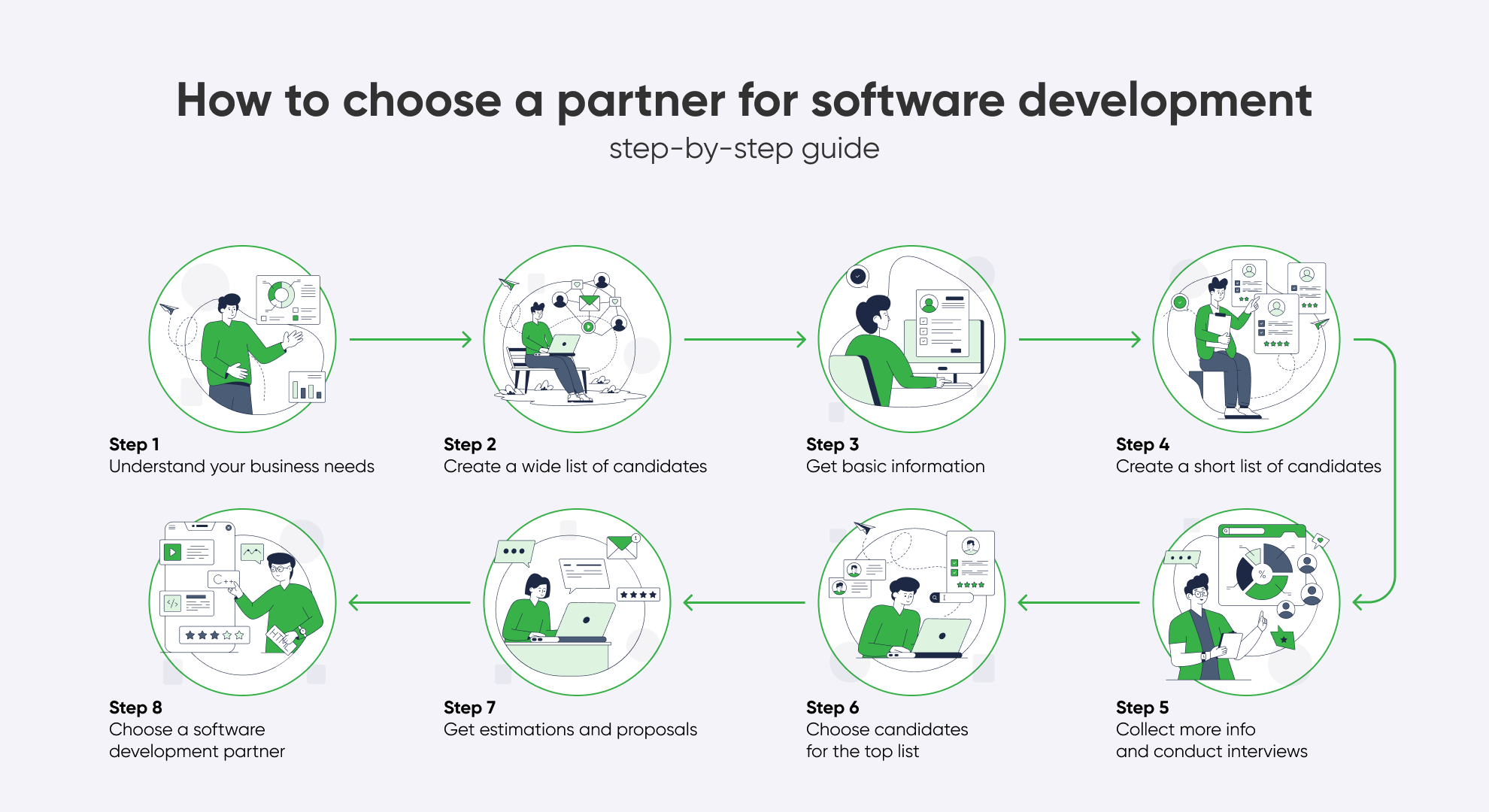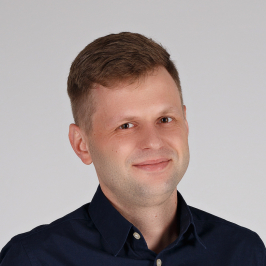Selecting a software development partner is a time-consuming task requiring responsibility and involvement at all process stages. According to Deloitte, a huge percentage of all companies turn to software delivery partners. And given the rapid development of technology, this trend will only grow.
As a customer-focused logistics software development company, we understand very well the major challenges that can arise when companies want to contract with a software partner. A future development partnership will have a huge impact on your entire project. Before you do anything else, it's important to make sure you have a game plan and a clear idea of what you're aiming to create.
We've broken this process down into individual guidelines, and this set of information serves as a measure to protect your company from software vendors who may expose your business to unnecessary risks. According to our methodology, you can use the wide, short, and top lists before selecting a partner. Below we will describe all the details of the formation of such lists and their practical value in the process. We also provide downloadable checklists containing important information to help you through the process.

So, let's get started!
What is a software development partner and why are companies looking for one?
First, let's define what a software development partner is and why many companies need to have one. A software development partner is an individual or organization that provides software development services, as well as related services such as mentoring, consulting, dedicated teams, and more.
Need a dedicated team to develop your project?
Learn how we can boost your business processes
Explore moreBut why do today's businesses need such a company? It's simple, business complexity has brought to light that there is no one-size-fits-all solution. Accordingly, the demand for systems capabilities has also increased along with the growing complexity of processes. Also, due to extensive technological diversity, maintaining a permanent staff dedicated solely to developing information systems might be inefficient.
So, Let's take a look at the main reasons for looking for a software partner:
Access to domain knowledge. One of the most valuable is domain knowledge, that is, a deep understanding of the business, processes, and industry. Domain knowledge can speed up development and reduce costs, especially for complex projects.
High-quality development team. Having a proven team and software development partner will make the development process much more efficient.
Team flexibility and scalability. By choosing a reliable software development company, you get a diverse team of software developers with all types of skills. Those niche experts can help you understand the market from both a technical and subject matter perspective.
Working with a manager. A project manager coordinates the team's efforts and reduces the risk that you will have to supervise individual team members yourself.
Top tips before starting to look for a software partner
There is no universal solution for every industry, so it's crucial to select a partner that meets specific requirements when outsourcing software development. The logistics industry follows its regulations and must consider regional economic changes impacting cash flow.
To help you better understand those concerns, here are some of the key attributes a logistics software development partner should include:
Industry expertise. A reliable logistics software development partner should have in-depth knowledge of the logistics industry.
Technological know-how. Proficiency is essential for developing software solutions compatible with evolving technology to be more agile in software development, especially, when integrating legacy systems.
Financial credibility. A trustworthy partner should demonstrate financial stability. This credibility ensures long-term commitment and the ability to be resilient to economic fluctuations.
Proven experience. Previous projects and customer feedback can indicate a partner's ability to meet expectations and deliver quality software.
8 key steps in the process of selecting a software development partner
Well, if you've figured out why you need a software development partner, it's time to dive into the search. This resource provides valuable information about the entire process. Following our guide allows you to filter out companies with undesirable characteristics for your organization and helps you to make the right choice.

So, here are 8 steps to help make a software development partnership work:
Step 1: Understand your business needs
The starting point is to define your business objectives. It will help you determine the main characteristics needed of your future partner and the level of compatibility of their services. We recommend two ways of creating and formulating your business needs.
Prepare a short query. At this point, you should set your expectations for meeting your business needs. In a short query, describe your problem, possible solutions, and the time frame needed for receiving a ready-made solution. By understanding the complexity of your problem, you can see which areas of your business are prone to inefficiency. This will help to highlight what custom software solution you need.
Prepare a long query. The idea here is to prepare detailed information that will help you categorize the problems that need solving. Ideally, this would include business requirements, user requirements, software requirements, and/or other details - everything that will describe your project more clearly for candidates. You may need to ask candidates to sign an NDA before sharing information about the project but this is optional.
Step 2: Create a wide list of candidates
To ensure a comprehensive approach, use a wide range of resources to create a wide list of candidates with 20+ companies. Consider all suggestions, such as recommendations from friends, and colleagues. Collect contact information and website URLs for each candidate.
Of course, you should also search for your new partner on Google, which will show you the best results that match your request. These may be great companies, but not every company on the list will be right for you.
At this point, you may be wondering, “Where else can I find software development partners?”
It may be helpful to look beyond basic Google searches. Many companies have profiles on Clutch and GoodFirms. These excellent listing platforms are based on real reviews and data and provide reviews and ratings for top IT outsourcing companies. You should also pay attention to Quora - one of the best online sources for facts and honest opinions. There are other specialized platforms such as GitHub or Stack Overflow, a place where experienced software developers share their knowledge and experience.
For data collection, to choose a software partner, you can use this Customer Relationship Management (CRM) or just a simple list from the Google spreadsheet.
✅ Download the template here

Step 3: Get basic information
The starting point for obtaining basic information is to evaluate the historical performance of existing partners and conduct an assessment. Reputation can be checked directly by searching for a company on online review platforms such as Clutch, GoodFirms, Glassdoor, Google, etc. At this point, select stop factors to filter out unsuitable candidates. Pay attention to the language you choose to communicate in, poor employee or customer reviews, or open court cases.
Check industry expertise, and make sure the company is well positioned and an expert. Look at industry pages and case studies. You may already be able to find cases similar to yours in the portfolio.
If you already know the technologies that you are planning to implement in your project, explore this issue with potential candidates. Check which tools have already been used in projects similar to yours, if any.
The next step is one of the most important. Here you evaluate the level of communication and willingness to help you with your request. Send a short request to 10-20 companies and evaluate the speed and quality of their responses. You can quickly remove candidates who cannot help you with your request or whose response was poor or too slow.
Here we offer an evaluative list of indicators that are important to collect, analyze, and evaluate when choosing a partner:
PRO TIP: Provide feedback to all companies to avoid mailings, subscriptions, and calls in the future. "We have found another partner for this project, thank you for your interest." is a completely appropriate and clear answer!
Step 4: Shortlist candidates
Here we will focus on the process of selecting potential partners from a wide list to a shortlist of candidates from 5-15 companies. It is important to rely on a combination of scoring and personal intuition. Please note that even if a potential partner does not meet absolutely all technical requirements, but your personal feelings are positive, add him to the shortlist to eliminate doubts.
The essence of this step is the careful selection of candidates from a wide list to a short one. You will need to conduct interviews to obtain more in-depth suitability assessments with each shortlisted agency. In the long term, this will provide confidence, and cast doubts aside, and you will always have detailed information about other potential companies for cooperation or individual projects.
PRO TIP: Remember, the number of in-person meetings depends on how much time you have at this stage to select a software partner according to your roadmap. Do not include too many candidates it could be overkill
Step 5: Collect more info and conduct interviews
Now you have potential candidates, let's move on. Determine the factors and criteria that are important to you based solely on your experience. Remember, these may vary for each industry, but we still suggest taking a look at our guide to learn more about software partner evaluation factors.

Do another round of online research and pay attention to the issues that concern you. For each potential candidate, you will want to find out some specific details. Let's do that to dispel any last doubts!
You are now at the stage of scheduling online meetings with potential candidates. Please note, to avoid issues in the selection process, schedule a 60-minute interview, but prepare thoroughly by making a list of questions in advance. Avoid short and multiple interviews, this may complicate the selection process and be more time-consuming than it’s worth for you and the potential partner. All information and feedback received during the interview should be documented to avoid omissions. This can be done using your preferred tool or a simple Google sheet that we have provided above in the downloadable checklist.
Step 6: Choose candidates for the top list
After a series of interviews, you have collected key information about your potential partners and this has allowed you to narrow the list again to the top options of 3-5 companies. This gives you a great opportunity to go back to all the indicators mentioned earlier. Consider involving your peers in this process, participating in discussions, and working together to create an even more comprehensive list of the top companies. This collaborative approach optimizes the decision-making process.
At this point, consider how potential partners can integrate into your internal team in the future. There is always some risk, when choosing, keep in mind that a potential partner using a team approach will be better suited for projects that require collaboration and constant communication. Autonomous work in this case can lead to misunderstandings on both sides.
Finally, evaluate communications. Be sure to explore potential cultural differences that could create problems between companies.
Step 7: Estimations and proposals
At this point, you already have a list of the best compliant companies. Now it's time to contact software development companies for project estimates.
The basic process includes initiating a non-disclosure agreement (NDA). This step is optional, but it protects valuable data and other aspects while ensuring that the potential partner maintains confidentiality about the project.
Next, send candidates extensive information about the project (a long query) and give them time to estimate. Involve your team members in further negotiations and conduct another round of interviews to review potential partners' proposals and discuss technical details.
PRO TIP: If you wish, you can request the contact information of previous clients to communicate in more detail and find out how their relationship with the candidate developed. You may need such information in case of any doubts, or additional questions, and you can focus on any details that are essential to your project.
Step 8: Choose a software development partner
At this point, we complete the assessment process and select the partner with whom we are ready to cooperate on the project. Although this process involved numerous steps it also provided us everything we needed to begin working together.
Now you can be confident that you have one of the best-in-class solutions for your business and strengthen your partnership with a Master Services Agreement (MSA) before moving forward with your project.
Are you in search of a reliable tech partner?
Adexin can help with advanced logistics solutions
Contact usFinal takeaway
The next steps include involving a partner and familiarizing the external team with the project. The presented algorithm is one of the best ways to find a business partner for custom software development based on our experience. Working with a third-party company reduces risks and speeds up project implementation.
As you may already know, Adexin takes a strictly customer-centric approach to providing the best results to our clients. "How to сhoose a partner" is created to provide a reliable way forward in selecting a partner for your logistics, transportation, and supply chain software projects. If you would like to learn more, we can schedule a call to discuss reliable support for your upcoming project.
In conclusion, we would like to say that although finding software development partners is not easy, it is possible and we are here to help!
Good luck with your project!

